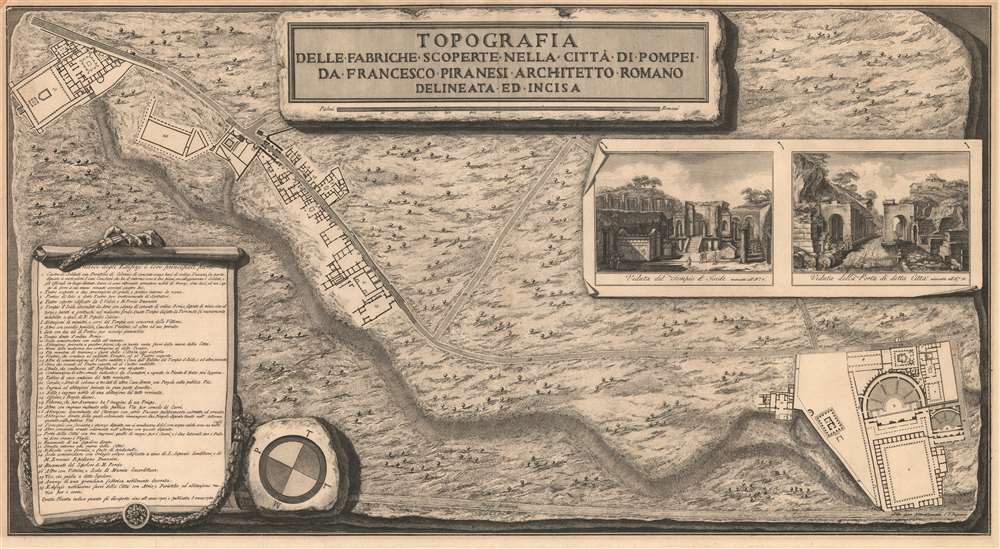Digital Image: 1785 Piranesi Ichnographic City Map or Plan of Ancient Pompeii, Italy
Pompeii-piranesi-1785_d
Title
1785 (dated) 18 x 32.5 in (45.72 x 82.55 cm) 1 : 1300
Description
FOR THE ORIGINAL ANTIQUE MAP, WITH HISTORICAL ANALYSIS, CLICK HERE.
Digital Map Information
Geographicus maintains an archive of high-resolution rare map scans. We scan our maps at 300 DPI or higher, with newer images being 600 DPI, (either TIFF or JPEG, depending on when the scan was done) which is most cases in suitable for enlargement and printing.
Delivery
Once you purchase our digital scan service, you will receive a download link via email - usually within seconds. Digital orders are delivered as ZIP files, an industry standard file compression protocol that any computer should be able to unpack. Some of our files are very large, and can take some time to download. Most files are saved into your computer's 'Downloads' folder. All delivery is electronic. No physical product is shipped.
Credit and Scope of Use
You can use your digial image any way you want! Our digital images are unrestricted by copyright and can be used, modified, and published freely. The textual description that accompanies the original antique map is not included in the sale of digital images and remains protected by copyright. That said, we put significant care and effort into scanning and editing these maps, and we’d appreciate a credit when possible. Should you wish to credit us, please use the following credit line:
Courtesy of Geographicus Rare Antique Maps (https://www.geographicus.com).
How Large Can I Print?
In general, at 300 DPI, you should at least be able to double the size of the actual image, more so with our 600 DPI images. So, if the original was 10 x 12 inches, you can print at 20 x 24 inches, without quality loss. If your display requirements can accommodate some loss in image quality, you can make it even larger. That being said, no quality of scan will allow you to blow up at 10 x 12 inch map to wall size without significant quality loss. For more information, it is best consult a printer or reprographics specialist.
Refunds
If the high resolution image you ordered is unavailable, we will fully refund your purchase. Otherwise, digital images scans are a service, not a tangible product, and cannot be returned or refunded once the download link is used.
Cartographer
Francesco Piranesi (c. 1758 - January 23, 1810) was an Italian architect, etcher, and engraver. Born in Rome, Piranesi was the eldest son of the more famous Giovanni Battista Piranesi and continued his father's series of engravings of monuments and ancient temples. Piranesi was taught engraving by his father alongside his elder sister Laura (1755 - 1785) who was also a noted engraver. By 1775, Piranesi was producing his own work and assisting with this father's. Piranesi also studied engraving, landscape painting, and architecture with other experts. He accompanied his father on trips to Paestum, Pompeii, and Ercolano in 1770 and 1778 and completed a series of drawings of Paestum started by his father Giovanni Battista. Following his father's death in shortly after the second trip to Pompeii, Piranesi inherited his father's publishing house and printed many of the later editions of his father's work. Following the 1798 invasion of Italy by the French Revolutionary Army, which established a short-lived Roman Republic. Piranesi distinguished himself in the eyes of the French officials and was named to a government post. After the fall of the republic the following year, Piranesi and his brother Pietro moved to Paris, where they attracted the admiration of several officials, including Talleyrand. They opened a branch of their business in Paris, called Piranesi Frères, but by 1807 Pietro had sold his share of the business in Paris and returned to Rome. After his brother left Paris, Piranesi fell on hard times. Emperor Napoleon Bonaparte came to his aid and issued an imperial decree granting him the sum of 300,000 French francs if Piranesi would dedicate himself solely to engraving, as he was then considered to be the best engraver in Europe. However, Piranesi suddenly died before finishing the contract. It is rumored that he died of syphilis. More by this mapmaker...

